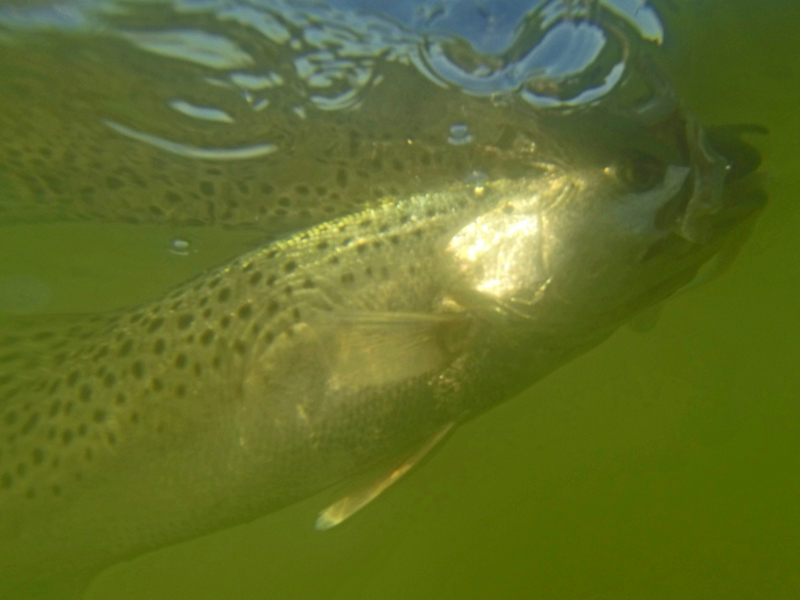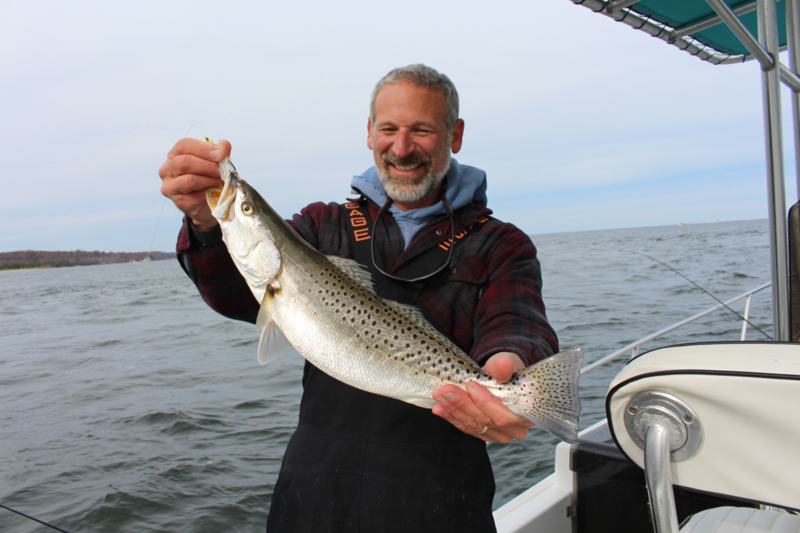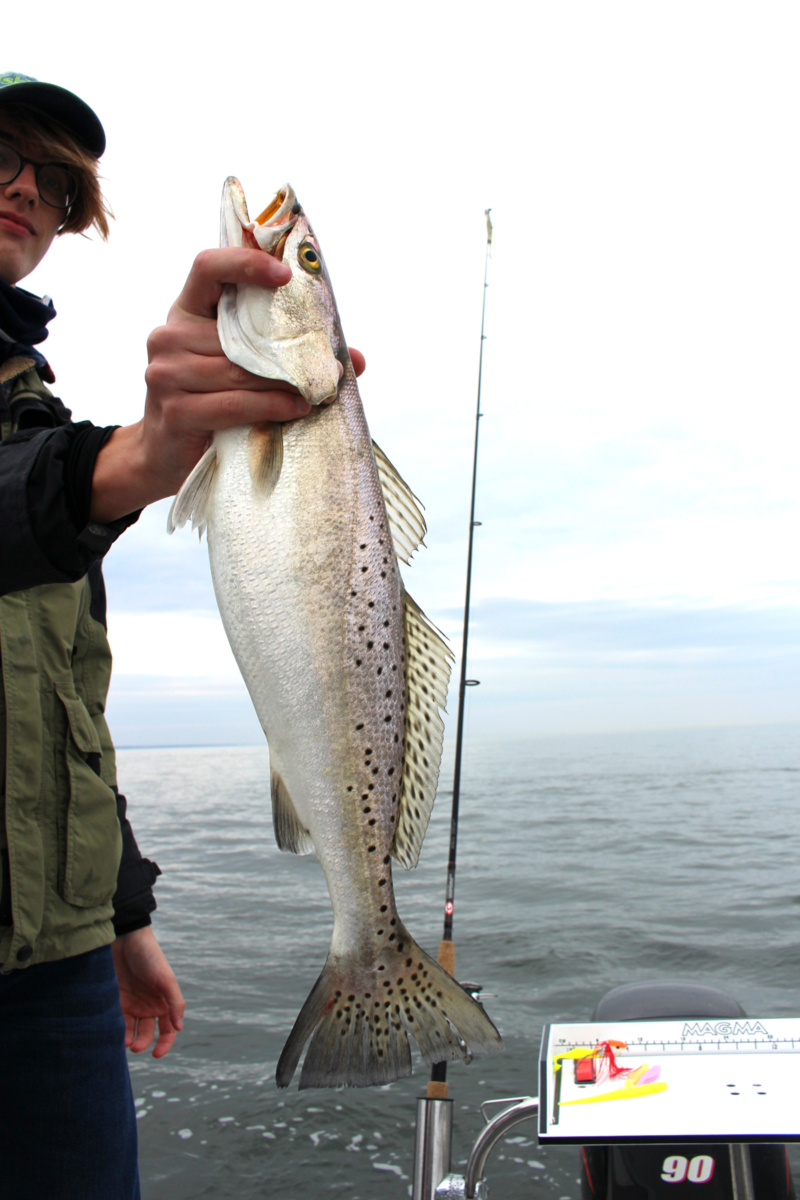Fishing for speckled sea trout can be downright maddening. You hear there’s a red-hot bite one day, and the very next morning you can’t buy a strike to save your life. One moment you get a hookup on every other cast, then out of nowhere they shut down cold. And sometimes, one person aboard a boat catches one fish after the next while all the other anglers stare, jaws agape, unable to score a single fish. That last scenario is often when the herky-jerky is doing its magic.

What the Heck is the Herky-Jerky!?
Herky-jerky is the name I use to describe a certain retrieval technique for targeting specks with soft plastic jigs, which is sometimes the hands-down best way to get the fish biting. If there’s a “proper” name for the style, I haven’t heard it. And the herky-jerky is not effective all the time — in fact, when the fish are favoring a slower or steadier retrieve it can be completely ineffective. Without having done any pseudo-scientific study, my gut tells me it out-fishes other retrieves a bit less than 50-percent of the time, perhaps in the 35- to 45-percent range. The critical thing to keep in mind is that it tends to work when other retrieves don’t.
I can trace my first experience with the herky-jerky to a press gig that included a day of guided light-tackle casting in Sarasota, FL, a decade or so ago. The bite was very slow, and as a matter of experimentation I tried a fast snap-jig retrieval approach similar to what one might use on the Bay when jigging soft plastics for rockfish. Never having applied it in the situation and wondering if that was simply too aggressive a presentation for specks, I asked our guide if he thought I was working the jig too erratically. He harrumphed and said “I don’t think it’s physically possible for you to make that thing move too erratically.”
Just to be a smart*** I grinned, said “oh yeah?” and started whipping my rod tip back and forth like nuts. I think you can guess what happened next.
WHAM! I was hooked up. Then, mimicking the same motions, it happened again on the next cast. And a few minutes later, again. The other two anglers aboard started flailing their rods as though they were attempting to scare away any fish that might be thinking about eating their jigs, and the bites came one after the next.
Jigging That's Emphatically Erratic
The dictionary defines “herky-jerky” as “characterized by sudden, irregular, or unpredictable movement and style.” And this actually sums up the retrieval technique pretty accurately. It can be difficult to force yourself to not retrieve with a steady cadence and rhythm. Your brain and your arm naturally want to create patterns, and you’ll have to actively resist this to employ the herky-jerky.
Let’s go through a single cast: Let that jig fly, hit the water, and sink down to the bottom. Take up slack, lift your rod tip so the jig comes off bottom, and take half a crank on the reel. Then whip the tip back and forth a few times in quick succession, maybe eight or 10 inches per whip. Move that tip back and forth so fast that the line goes slack, then jerks tight, then goes slack, then goes tight — all in the space of one second or less. Take two cranks on the reel and give a single long, fast, snap-style jigging motion. Whip the tip twice more, then allow the jig to sink back to bottom. The moment it hits bottom pop it back up, then whip-crank-whip-whip-pop-snap-pop-pop-whip-sink. On your next cast take these whips, cranks, snaps, and pops, jumble them up, and use a completely different non-cadence. Get that jig dancing around in a manner so erratic that you think it’s more likely to scare the specks than it is to get them biting, and WHAM!

Many anglers, myself included, find it helpful to envision how a lure looks and moves as they retrieve it beneath the surface of the water. In this case, I picture my jig jumping up a foot or two off the bottom, going into violent spasms and almost vibrating in place at times (the whip-whip-whip), and then sinking back to the bottom.
Note: the strikes almost always come as the lure sinks down after all that herking and jerking, or during a moment of smooth movement during a crank. So, when you let the lure drop or take in line, it’s critical to maintain tension in order to feel the strike.
When to Be a Jerk
As stated earlier, the Herky-Jerky is not a technique that works all the time. Last season in the six targeted Chesapeake Bay speck trips I caught fish on, it proved ineffective (completely) on three of the occasions, so-so on one more, and utterly deadly on two of them. The two trips when it was the hands-down winner, the herky-jerky accounted for eight fish while other retrieves accounted for absolutely zero — even while using the exact same lures.
Speaking of lures: I have three favorites for this technique, each of which has proven a winner at different times. The first is a four-inch white paddle-tail, the second is a bubblegum-pink four- or five-inch Fin-S style straight split-tail, and the third is a five-inch Gulp! Jerk Shad in white or chartreuse. All are fished on leadheads from a half-ounce to one ounce depending on water depth; figure on a half-ounce in water of six feet or less and work your way up from there, remembering that it’s critical to be able to feel the jig tap down on bottom and maintain tension as it falls.

So, when should you start herking and jerking? Got me. The only way I know of to find out if it’ll be the retrieve du jour is by experimenting. Specks are notorious for changing their preference between retrieve styles from day to day and even tidal cycle to tidal cycle, so it’s always wise to alternate between fast, slow, shallow, and deep until you figure out what the fish want at any given time. Just add the herky-jerky method into your repertoire as you try different styles. And when it produces a hit, naturally, keep it up.
What about other species? If the herky-jerky works for ‘em, I haven’t yet found the right situation. You will catch a few stripers and possibly an oddball redfish while using it, but you’ll catch a whole lot more using other retrieval techniques. As far as I can tell, this is really a very species-specific, limited-application method. But when the herky-jerky works it works like magic — master it, and one day you might see some jaws dropping among the other anglers on your boat.
-By Lenny Rudow